This is the first post in several weeks and I must apologize for the delay. Getting my website up and running has been a mammoth task that has taken all my time. However, now that it is largely complete, I can turn my attention back to writing my blog posts.
You may recall that the last post dealt with most aspects of the 2.5d lake stamp from the first Unwatermarked Waterlow printed set from the Niger Coast Protectorate. Today, I will finish my exploration of this stamp off, with a detailed look at the perforations, and then I will begin to look at the 5d value.
Gibbons lists four perforations on this value:
- 14.5-15,
- 13.5-14,
- 13.5-14, compound with 12-13, and
- 12-13
However, these perforations are greatly oversimplified. I have gone through my stock of 86 mint and used examples of this value with my Instanta perforation gauge, and from this examination, I have found the following combinations:
- 15 x 15.1
- 15.1 x 15.1 x 15.1 x 14.9
- 15.2 x 15 x 14.1;14.9 x 15
- 14.8 x 14.6 x 14.8 x 14.8
- 15.1 x 15 x 15 x 15.1
- 14
- 14.5
- 14.3 x 14.3 x 14.3 x 14.5
- 15
- 14.7 x 14.9 x 14.8 x 14.5
- 14.9 x 15 x 15.1 x 15
- 14 x 14;12
- 14.9 x 14.6
- 15.1 x 15 x 15 x 14.9
- 15 x 14.8 x 14.9 x 14.6
- 15.3 x 15 x 15 x 15
- 14.5 x 14.5 x 14.8 x 14.7
- 14.6 x 14.8
- 14;12 x 14 x 12;14 x 14
- 15 x 14.6 x 14.9 x 14.4;14.6
- 14.1 x 13.9
- 12.4;12.6 x 14;12.1;12.2 x 14.3 x 14.2
- 14.9 x 14.8
- 15 x 14.9 x 14.8 x 14.8;14
- 15.1 x 15
- 15 x 14.8 x 14.9 x 14.8
- 14 x 14 x 14 x 14.1
- 14.8 x 14.9
- 14.9 x 14.5
- 14.1 x 14
- 14.6
- 14.5 x 14.6
- 14.5 x 14.8
- 14.8 x 14.5
- 15 x 14.8
- 13.8 x 14
- 15 x 15 x 15 x 14.8
- 14 x 13.3;12.4;12.9
- 14 x 14.1 x 14 x 14
- 14.5 x 14.5 x 14.8 x 14.5
- 14.7 x 14.5
- 14.3 x 14.7
- 15 x 14.9 x 15 x 15
- 14.8 x 14.8 x 14.6 x 14.8
- 12;12.6 x 14 x 14 x 14
Thus I have found 45 different perforation varieties. Most are variations of 15 and 14, with a smaller number of 14.5 and compounds with 12-12.5. The whole perforation measurements of 15 and 14 are by far the most common, with 22 of the 86 examples of this stamp being perf. 15, and 8 being perf. 14.18 of the 45 listed varieties above are all close variations of these two measurements, through in most cases, there are only 1 or 2 examples of each. The remaining 25 varieties are either perf 14.5, are close variations of 14.5, or are compounds containing variations of 12. Only 5 of the stamps here are the compounds containing 12, or variations thereof - in other words about 5% of the total.
These proportions are consistent with the differences between the Gibbons catalogue values for the different varieties, though the price differences are not always as great as one would expect. For example, the difference between the price of the most common perforation in mint condition and the 12-13 x 13.5-14 compound is only 21 pounds - just over double, whereas the difference between prices for used copies is almost 10:1
What is of particular interest to me are the compounds in which the gauge of the perforation changes twice on a particular side, and not just once.
The 5d Lilac
This, to my mind is the most interesting stamp of this series, due in large part, to the sheer variation in the shades of colour in which it can be found. In addition to this there are the usual perforation varieties, paper varieties and plate flaws. Today, I am going to look at the shade varieties, paper varieties, plate flaws and cancellations on this value.
Shades
Gibbons lists only 2 shades of this stamp: lilac and grey lilac. In reality there are at least 5 major shade varieties, and many sub-varieties. I have identified no fewer than 26 shade varieties, as illustrated below:

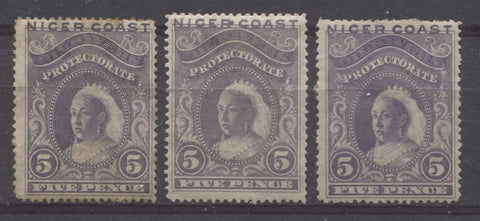
The above 8 stamps represent 8 different shade variations of slate purple or grey lilac as seen on the Gibbons colour key.
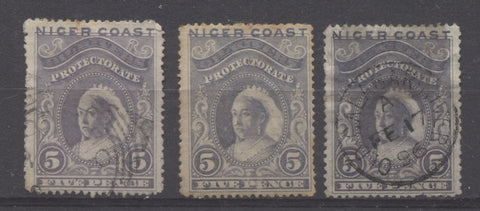
These three shades are over toward the grey end of the colour key, and contain different amounts of lilac and lavender. They are variations of the lavender grey and violet grey.

The two stamps on the left are shades of grey violet and grey lilac, while the two stamps on the right are shades of brownish grey.

These are shades of grey, which contain only a hint of purple or green, as the stamp in the centre.

These are all shades of slate, which contain varying amounts of green, blue and purple.
Paper and Gum Types
I note that there are six different types of paper on these stamps, and three different types of gum. Of the six types of paper, one shows no distinct mesh pattern, and is very scarce, four show a vertical mesh pattern, and one shows a horizontal mesh pattern. The horizontal wove papers are thus, much scarcer than the vertical wove papers. In terms of gum, the three types can be described as follows:
- A thicker, smooth colourless gum that has a semi-gloss sheen. This is usually found on the vertical wove paper with closely spaced mesh.
- A thicker, smooth cream gum that has a semi-gloss sheen. This is usually found on the thicker, soft vertical wove with the coarse mesh.
- A thinner and slightly crackly, though generally smooth, colourless gum, that has a satin sheen.
The six types of paper are shown in the scans below:

Here we have the thick, soft wove paper that shows no clear mesh pattern, which is apparent from the appearance of the bottom half of the stamp.
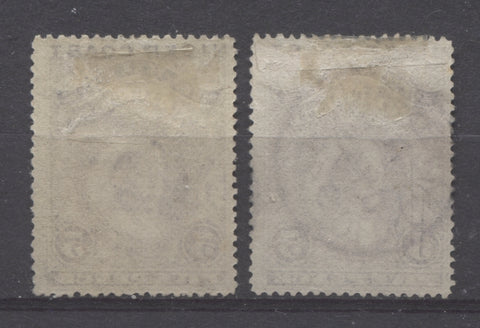
The paper shown here is the first variation of the vertical wove paper. This type is translucent, soft wove that has vertical mesh that is relatively fine and closely spaced. The gum on the left hand stamp is the first type described above.
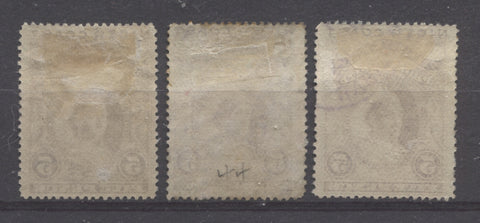
Here, we have the translucent vertical soft wove paper, that has the coarse mesh. The gum on the two mint stamps is the first type described above.

The vertical wove paper shown here is noticeably more opaque and soft. It has a relatively coarse mesh pattern and the gum on the mint stamps is the second type described above.
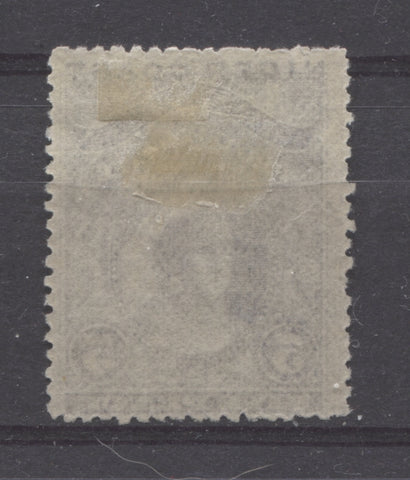
This is the last of the vertical wove papers. It is the thin, hard wove paper with the coarse mesh. The gum on this stamp is the third type described above.

This is the only type of horizontal wove paper I have come across on this issue. It is identical in all respects to the hard vertical wove above, except that it is horizontal, instead of vertical. The gum, once again, is the third type described above.
Cancellations

Three Bonny River CDS cancellations, all time code A, and two squared circle cancellations, also time code A.
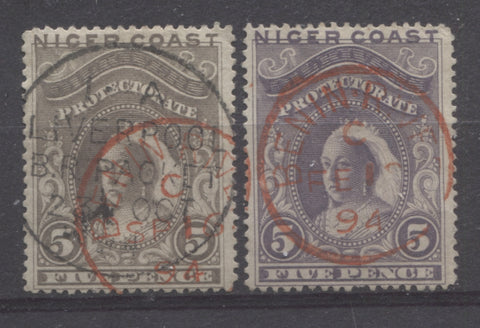
These two stamps show the scarcer red CDS cancel of Benin River, both being time code C. In addition, the stamp on the left shows a fantastic strike of the black Liverpool Packet CDS, which is not usually seen on stamps, but on the envelopes to which the stamps have been affixed.

Four stamps with the Brass River CDS cancel and one squared circle. These are a mixture of time codes A and C.

One CDS and one squared circle cancellation from Opobo River. Both are time code A.
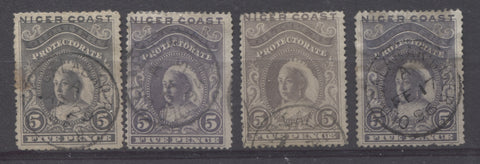
Four stamps showing the Old Calabar River CDS cancel, and all time code A.
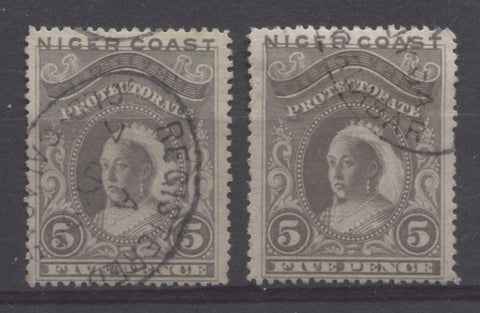
Two stamps showing the scarce old Calabar registered oval cancellation. The only fully readable strike is time code A.

Five stamps showing the smaller, Old Calabar CDS cancellation. These are also a mixture of time codes A and C.
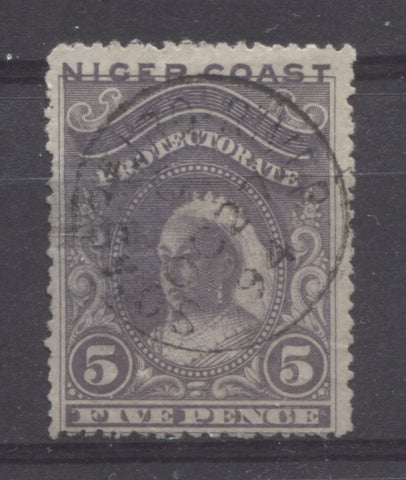
A somewhat unclear strike of the scarce Sombriero River CDS cancel, Unfortunately the stamp is severely thinned on the left side.
This concludes the start of my exploration of the 5d value and my post for this week. Next week I will look at the plate flaws and re-entries, as well as the perforations.

